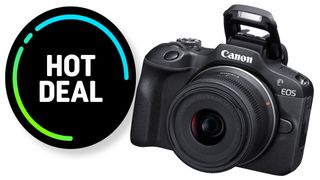In many ways, the Sony A7 IV is the perfect camera for wedding, social, and event photography. Its 30MP resolution is more than enough and a useful step up from 24MP rivals, and Sony has some of the best AF tech there is, including eye AF and Real-Time tracking.
The A7 IV is also ideal for video, because unlike higher-resolution Alphas like the A7R V, it can still capture full-width oversampled full-width 4K for best quality with no crop factor. More and more social photographers need to shoot video as well as stills, which makes the Sony A7 IV one of the best professional cameras and perhaps one of the best cameras for filmmaking. The highest-resolution cameras are great for stills, but more limited for video capture.
Client expectations are generally high for this kind of photography, so we think Sony’s G Master lenses, although expensive, are some of the best Sony lenses to get. You don’t need to get every lens on our list, obviously (!) and if we can suggest a cheaper alternative, we will.
We’ve chosen a range of lens focal lengths and lens types according to what we think the Sony A7 IV will be most used for, so here are our recommendations and why we think they are an ideal match for this camera and its users.
Best lenses for the Sony A7 IV in 2024
Why you can trust Digital Camera World
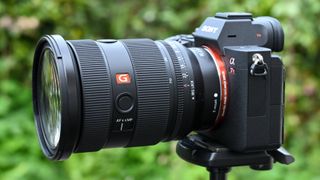
The original Sony FE 24-70mm f/2.8 G Master lens became the standard zoom lens of choice for any Sony pro, but it is a big and hefty lens to lug around. This new 'Mark II' version is shorter, lighter and has a new and more advanced optical construction. There’s handling exotica aplenty.
The zoom ring has adjustable torque, thanks to a smooth/tight switch on the underside of the barrel. There are two customizable function buttons, typically used for focus-hold, which fall naturally under the thumb whether you’re shooting in landscape or portrait orientation.
There’s also a new aperture control ring which comes complete with a click on/off switch, enabling precise aperture adjustment for stills and smooth de-clicked operation for movie capture. If the Sony FE 24-70mm f/2.8 G Master II is just too expensive, though, we'd also recommend the rather good Sigma 24-70mm f/2.8 DG DN Art.
Read our full Sony FE 24-70mm f/2.8 G Master II review for more details
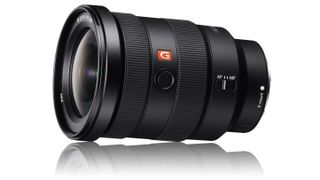
Featuring exotic glass that includes two ultra-high-precision XA (Extreme Aspherical) elements, the Sony FE 16-35mm f/2.8 G Master was Sony’s top-quality wide zoom until the arrival of the even wider Sony FE 12-24mm f/2.8 G Master.
For event photography, however, we think a 12-24mm is just too wide. This 16-35mm, however, doubles as an ultra-wide lens and a semi-wide everyday lens. For indoor shooting, it's an ideal 'standard' lens.
Other highlights include nano-structure coatings, a keep-clean fluorine coating on the front element, and extensive weather seals. There’s a fast and constant f/2.8 aperture and, when stopping down, the aperture remains extremely well-rounded thanks to an 11-blade diaphragm.
The DDSSM autofocus system is incredibly accurate and the lens also features a customizable focus hold button on the barrel. It is expensive, though, so you might also want too consider the rather good and much cheaper Tamron 17-28mm f/2.8 Di III RXD.
Read our full Sony FE 16-35mm f/2.8 G review for more details

Why a 70-200mm f/2.8? Because the longer focal range is ideal when you can't get up close to your subjects – very common at weddings! – and because the f/2.8 maximum aperture can give you really shallow depth of field, especially at 200mm.
In many ways, a 70-200mm f/2.8 is a better portrait lens than an actual portrait lens! The Sony FE 70-200mm f/2.8 G Master OSS is one seriously well-specced optic, with one double-sided XA (Extreme Aspherical) element, two other aspherical elements, four ED (Extra-low Dispersion) elements, and two Super ED elements.
There are not one but two autofocus systems, incorporating a double linear motor plus an RDSSM (Ring Drive Super Sonic wave Motor), the latter being used for the heavier forward focus groups. The construction is fully weather-sealed and includes a fluorine coating on the front element.
Handling is particularly refined, with an autofocus range limiter, customizable focus hold buttons, and dual-mode stabilization for static and panning shots. All this translates into decent performance.
Image sharpness is very good indeed wide-open at f/2.8, throughout the entire zoom range, becoming excellent at f/4. Color fringing is minimal but distortion is a little worse than average for this type of lens. You might also want to take a look at the much cheaper Tamron 70-180mm f/2.8 Di III VXD.
Read our full Sony FE 70-200mm f/2.8 G Master OSS review for more details
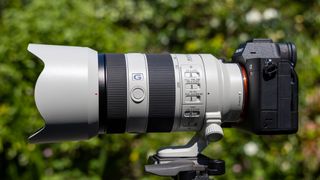
Many professional and enthusiast photographers consider a 70-200mm f/2.8 lens like the Sony FE 70-200mm f/2.8 G Master OSS (above) as the one zoom they ‘have to have’. But do you? If you don’t feel a burning need for that extra f/stop, this f/4 lens delivers spectacular image quality and all-round performance, wrapped up in a comparatively compact and lightweight yet robust build, at little more than half the price. It also adds 0.5x macro magnification for extreme close-ups. All in all, the Mark II edition of this Sony lens is a cracker. Compared with the original, it’s better, faster, more!
Read our full Sony FE 70-200mm F4 Macro G OSS II review for more details

For action, sports and wildlife photography when you need to swap between a standard field of view and serious telephoto reach for different compositions, there’s always the risk of missing a great shot while you’re changing the lens on your camera body. This Tamron lens solves the problem with its unusual 50-400mm zoom range, giving you both options in one package. It’s quite weighty for standard focal length shooting, at more than a kilogram, but has refined handling, fast autofocus and effective optical stabilization. It also delivers impressive image quality at all zoom settings. Ultimately, it can replace two separate lenses and is very good value at the price.
Read our full Tamron 50-400mm F4.5-6.3 Di III VXD review for more details
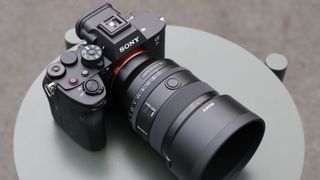
The Sony FE 50mm f/1.4 is the lens that is most suited to most Sony shooters, impressively light and compact, but not compromising one bit on optical quality, this lens is almost perfect when it comes to sharpness in the center. With only a small falloff towards the edges of the frame and some vignetting wide open, this lens gets almost full marks.
The 50mm perspective offers a very versatile focal length, and it is definitely a lens that can be left on your camera for a moment's notice. If you don't need the extra aperture stop, or the added size, weight, or considerable cost of the FE 50mm f/1.2 GM, then the Sony FE 50mm f/1.4 will serve you perfectly.
Unfortunately, the downside is the lens is expensive when compared to similar rivals, with much cheaper third-party glass out there that will achieve similar visual results. However, few which share quite the same size and weight, lightning-fast autofocus, and solid moisture-resistant construction that this lens offers.
Read our full Sony FE 50mm f/1.4 GM review.

A 24-70mm zoom and a 16-35mm will both cover the 35mm focal length, but neither will produce the results this lens can. A 35mm prime is often considered the perfect candid/street lens, offer a semi-wide angle of view for a large range of subjects – and the f/1.4 maximum aperture of this lens combines that wide view with strong background blur for unique environmental portraits.
It's a very versatile lens, suited to anything from portraits and weddings, to landscape and astrophotography. As you'd expect, it isn't cheap, but it delivers a spectacular optical performance.
It's not the smallest 35mm prime we've seen, but the handling really impressed, with a perfectly weighted ‘de-clickable’ aperture ring for vide, to the smooth and light focus ring.
A lovely lens, but it inevitably comes at a hefty price. Alternatively, why not consider the pint-sized Sony FE 40mm f/2.5 G? It's nowhere near as fast, but it's light and easy to shoot with and might be perfect for filming on a gimbal – and it too has a de-clickable aperture ring.
Read our full Sony FE 35mm f/1.4 G Master review for more details

A portrait lens is practically a must for anyone shooting weddings and events. The 85mm focal length gives natural-looking facial perspectives and the f/1.4 maximum aperture gives a beautiful background blur, helping to isolate your main subject against a blurred background.
As well as being super-sharp, the quality of the bokeh is wonderfully soft and dreamy, and remains so even when stopping down a little, helped by a very well-rounded 11-blade diaphragm.
It’s undeniably a very pricey lens but its performance more than justifies the cost. Talking of cost, though, there is a cheaper option which is almost as good. The Sony 85mm f/1.8 loses a little in maximum aperture, but its lighter and cheaper and a pretty stellar performer in its own right.
Read our full Sony FE 85mm f1.4 GM review for more details
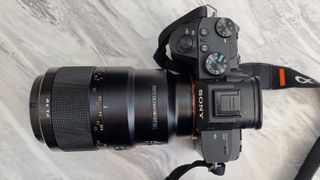
Most of the lenses on our list will focus close enough for flowers and decorations, but if you want to capture something as small as a ring, you need a proper macro lens. At its minimum focus distance of 0.28 meters, the Sony FE 90mm f/2.8 Macro G OSS lens delivers full 1.0x or 1:1 magnification.
That basically means that small objects are reproduced on the camera’s image sensor at full life size. Naturally, if you’re filling the whole image frame with something as small as a postage stamp, the potential for massively enlarging tiny details is enormous.
Beautifully built, this lens has up-market handling attractions including a customizable focus hold button, autofocus range limiter switch, and Optical SteadyShot.
Given that manual focusing is often preferred for extreme close-up shooting, there’s also a handy push-pull mechanism in the focus ring, for switching between auto and manual focus modes. It is pretty big and expensive, but keep in mind that it could also double as a portrait lens. You won't get the same background blur from its smaller f/2.8 maximum aperture, but you will still get the same flattering portrait perspective.
Read our full Sony FE 90mm f/2.8 Macro G OSS review for more details
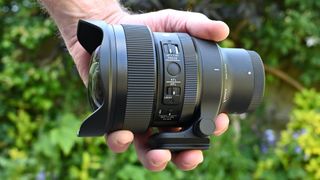
This is a beast of a lens that is designed for astrophotographers - offering an impressive f/1.4 maximum aperture, with an ultra-wide 14mm focal length. Sigma's previous 14mm for DSLR cameras could only manage f/1.8 - so this mirrorless-only version is a world-record breaker. Its light-gathering powers come into their own after dark but this is no one-trick pony – it’s also great for shooting landscapes, cityscapes, and architectural interiors, giving fabulous image quality backed up by superb handling and excellent build quality. In our laboratory tests, we remarked that the levels of sharpness are thoroughly excellent across the whole frame, even when shooting wide-open at f/1.4.
See our full Sigma 14mm f/1.4 DG DN Art review
How we test lenses
We test lenses using both real-world sample images and lab tests. Our lab tests are carried out scientifically in controlled conditions using the Imatest testing suite, which consists of custom charts and analysis software that measures resolution in line widths/picture height, a measurement widely used in lens and camera testing. We find the combination of lab and real-world testing works best, as each reveals different qualities and characteristics. You can find out more about how we test and review on Digital Camera World.
Read more:
Best lenses for the Sony A7C
Best lenses for the Sony A7 III
Best lenses for the Sony A7 II
Best lenses for the Sony A7R III and A7R IV



